The World Race to Sustainability
Imagine circumnavigating the world in a sailboat six times, and imagine seeing more and more trash each time. The Turn the Tide on Plastic skipper Dee Caffari knows a bit about the state of our oceans. When I interviewed her in June at the Newport stopover of this year’s Volvo Ocean Race, she relayed, “this is my sixth time around the world now, and there’s more rubbish than ever.”
Caffari is the only woman to have sailed solo around the world in both directions and the only woman to have sailed around the world three times, non-stop. Add to that her participation in the Vendee Globe, the Global Challenge, the Barcelona World Race, four transatlantic races, and the 2014-2015 Volvo Ocean Race.
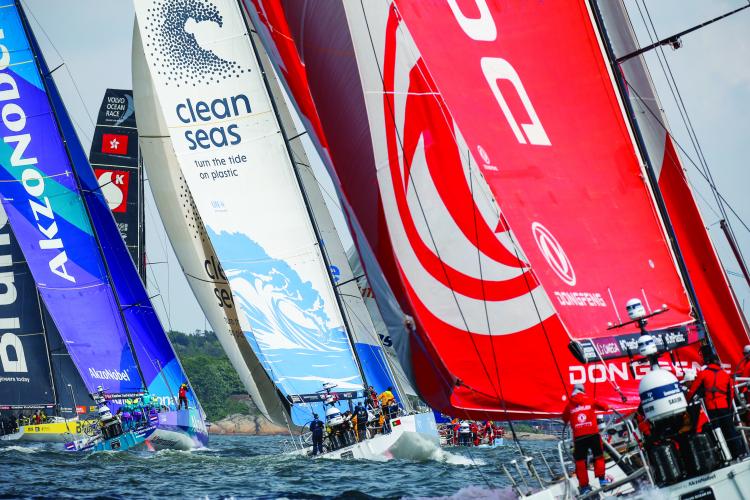
I first took notice of her and Turn the Tide on Plastic (TTTOP) as I watched the Volvo Ocean 65s racing in Leg 1 from Alicante, Spain, to Lisbon, Portugal. Under her direction as skipper, TTTOP was going to perform water quality and microplastics research throughout the 2017-2018 race. The data gathered across four oceans and in the waters surrounding six continents would be used to build ocean sustainability methods and models. The venture reminded me of the USS Triton (nuclear submarine) gathering water from 22 seas during what was the first submerged circumnavigation in 1960. Only now the water quality is much different; the state of the oceans is apparently at risk.
How much debris is out there?
We are in a bleak situation. According to the Sea Turtle Conservancy, “over 100 million marine animals are killed each year due to plastic debris in the ocean.” The University of Georgia in Athens and the National Center for Ecological Analysis and Synthesis (NCEAS) at the University of California, Santa Barbara, teamed up to develop a model to calculate global sources of ocean debris, then focused specifically on plastic. Their response plan to marine debris reflects their finding that the 192 countries located along the global coastline generate the bulk of plastic waste in the oceans; in 2010 they produced 275 million metric tons of plastic waste.
The Georgia/NCEAS team then calculated that five to 13 million metric tons of this plastic ended up in the ocean in 2010, and that by 2025 the annual cumulative output of plastic into the world’s oceans would be around 155 million metric tons. One metric ton equals 2205 pounds, so that roughly equates to 10 bags packed with plastic per one foot of coastline. I concluded that we are beyond what is generally thought of as sustainability, and well into crisis intervention.
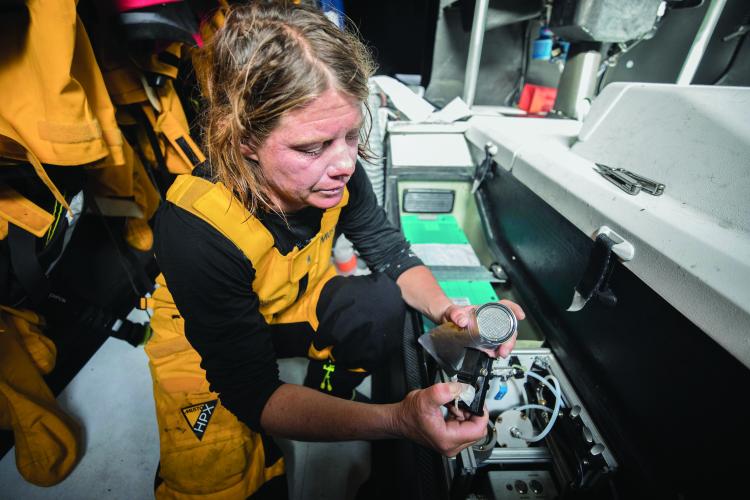
An Ambitious Undertaking
As I was already headed to Newport, RI, for the in-port race and start of Leg 9 to Cardiff, Wales, I decided to research Volvo’s sustainability efforts and TTTOP’s ambitious undertaking.
Volvo holds an Ocean Summit at each host city, bringing together “government, industry, scientists, and advocates to explore solutions to the ocean plastic pollution crisis.” Attending the Newport Ocean Summit, I was immediately immersed in a world of microplastics, water columns, degradation percentages, marine habitats, phytoplankton, biomass, and international science diplomacy. Despite hailing from many different countries, everyone was speaking the same language on the vast extent of the problem, with insight and commitment.
Clear, compelling research on the breadth of the marine debris issue at hand and the staggering issue on our doorstep was presented and covered much more than the commonly heard talk about plastic bags. The total spectrum of marine species impacted [all!]; the fisheries impacted and reduced fish stocks available to feed both the rich and poor; the challenge in recycling plastic due to the 700 different polymers it’s made from; the necessity of circular supply chains and upcycling; and the fact that it’s likely the fish we eat and the tap water we drink could contain microplastics.
A room packed with highly engaged people peppered Charlie Enright, skipper of 11th Hour Racing, and Caffari with questions on what they had seen on and in the oceans as they traversed the globe. The Schmidt Family Foundation (a philanthropic organization providing resources to solve global science, energy, and sustainability challenges) sponsors 11th Hour Racing, so at present there are actually two boats in the fleet dedicated to sustainability and marine stewardship.
Caffari and Enright both concurred that marine pollution was the worst sailing through the Straits of Malacca (4.66° N, 99.55° E), the narrow, 550-mile stretch of water between the Malay Peninsula and the Indonesian island of Sumatra.
“There was trash everywhere,” Dee said and commented that while she has enjoyably sailed the Straights in previous VORs, her young crew had not. For her crew this is not even a crisis intervention issue. For them we have to turn back time.
“It prohibited performance,” said Charlie, illuminating that it’s the marine trash that’s impacting the race, not the water sampling.
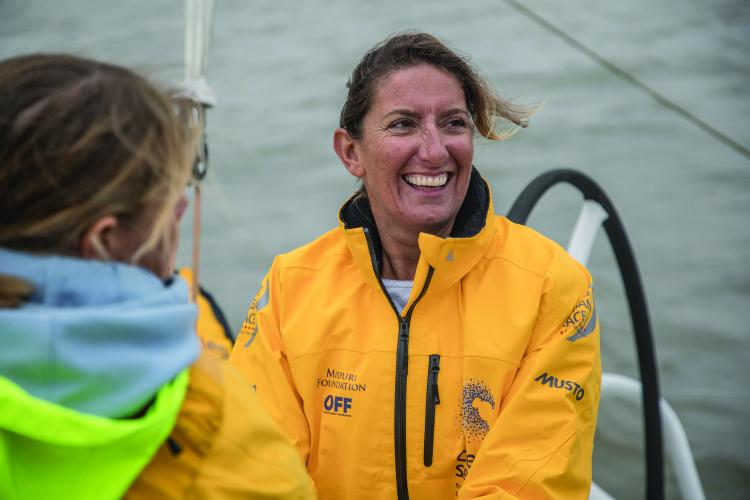
The Problem With Data
According to Kara Lavender Law, research professor of oceanography at the Sea Education Association in Massachusetts, digestion of microplastics (plastic pieces five millimeters or smaller) is well-documented in mammals, fish, birds, and invertebrates in laboratory studies, but scientists don’t know the extent of microplastics distribution in the oceans, nor how these plastics are physiologically damaging marine life. Only in recent years has there been an acceleration of research activity. Despite international interest and research funding, data are minimal and scattered. And the problem compounds: microplastics become increasingly concentrated as they are transferred up the food chain.
Law explained that microplastics travel and permeate the oceans in “unpredictable ways.” They can be found throughout the water column: on the sea surface down to the sea bed. Scientists have made some progress surveying vast areas of open sea, but Law explained that studying the deeper water column and seafloor is significantly more difficult. As miniscule pollutants, the tiny plastics find their way far from land and coastline. TTTOP water sampling revealed microplastics at Point Nemo, the most remote location on the planet. The International Space Station orbits Point Nemo at a closer distance than the nearest land mass lies, but measurable levels of microplastics have found their way to Point Nemo.
“In order to more comprehensively assess the risk of these pollutants in the natural world, scientists have to determine how often animals encounter them in their natural settings,” said Law. However, “because they are so small, they can’t be detected by remote methods like satellites. We must rely on ships in the open ocean.” Enter the Volvo Ocean Race.
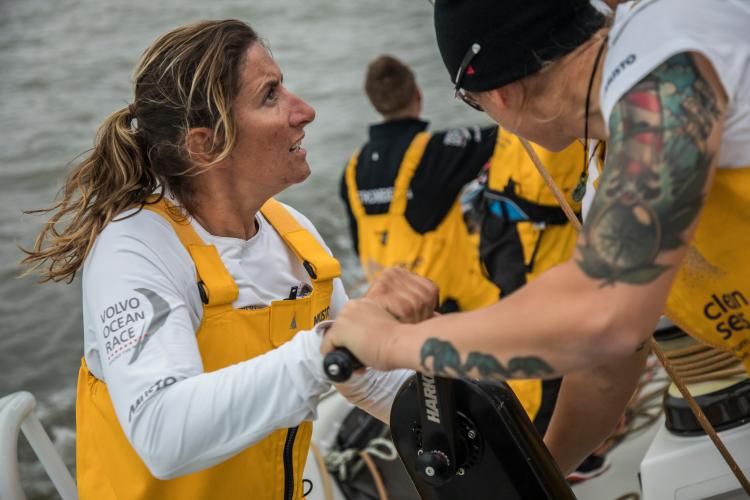
Racing Where Scientists Can’t Go
Anne-Cecile Turner, Volvo Ocean Race Sustainability Program leader, laid it out, stating that “the boats are going in the most remote places on earth: in the area where nobody goes, where the scientists can’t go. So, the idea behind that was: ‘Why can’t the boats contribute to the data collection, to a better scientific understanding of what’s happening out there?’”
According to Turner, in addition to the Point Nemo findings TTTOP data revealed microplastics in Antarctic waters. “We are now understanding the scale of the issue,” Turner said. “We have managed to collect groundbreaking data. The race has a pivotal role to play in advancing our knowledge of this area of science.”
In fact, the impact of the data gleaned by TTTOP water sampling led team AkzoNobel, one of two Dutch race entries, to add the water sampling equipment to their boat. According to Enright, if more sampling machines had been available, 11th Hour would have welcomed one to their boat, adding that perhaps in the future all VOR boats would carry this scientific cargo. TTTOP and team AkzoNobel receive a handicap to compensate for the equipment’s weight; in the spirit of one-design racing having the same equipment on each race entry would make sense.
Dr. Sören Gutekunst, an oceanographic scientist at the GEOMAR Institute for Ocean Research in Kiel, Germany, analyzes the preliminary microplastics data. “I go to the stopovers and pick up the microplastic filters that the team collects as well as the rest of the data that’s gathered by the onboard systems.”
Back in Germany, Gutekunst leverages high-energy lasers and computer programs to measure for microplastic concentrations and cross checks results manually. “This process takes around two hours per filter, and the boats each collect three filters every two days.” In addition to microplastics testing, Gutekunst and GEOMAR measure temperature, salinity, carbon dioxide, and chlorophyll. Ultimately, the collected and analyzed data will be published as open source research for the scientific community and the general public’s use.
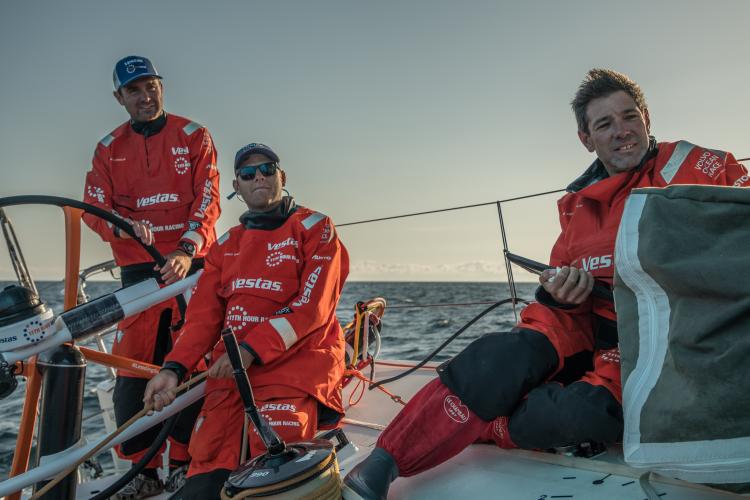
Six Times Around the World, Yet…
I had about five minutes with Caffari as she prepped for the in-port race at Newport. She was outside the Sailor’s Terrace getting ready to head to the dock, so while we spoke, she donned her gear. I asked Caffari if the water testing had resulted in TTTOP going off course.
“We sail the boat, and [the water is] only analyzed when we make water,” was her prompt reply. “It fits into our routine; we don’t fit into its routine.” All boats have onboard water makers, so Caffari and her crew determined that performing double duty running the water maker and swapping out the water sampling filters was the best approach to getting the research accomplished.
It turns out that the skipper had had serious doubts about adding environmental research into the mix of trying to win a circumnavigation. She was quite reluctant at the proposition. When asked about her current view of the initiative, she said, “It’s probably one of the best projects I’ve been involved in. The communication is very genuine, the messaging. And to have a youth crew, they are probably more genuinely passionate about it, and they realize it’s their generation that’s handing it over to their children. They want to start the change.” Another vast difference between TTTOP and her competitors is that Caffari’s multinational crew has a gender ratio of 50-50 male to female racers, with the majority being under 30 years of age.
She further explained that the water quality sampling is a straightforward process. “It’s very simplistic for us. It’s quite low maintenance. We just literally have to change the filters, and Liz [Wardley] has taken that onboard.” Dr. Gutekunst meets the boat at every port, which provides the opportunity to do a status check on equipment and data gathering.
She kind of made it seem too easy. But if one of the world’s top racers could tackle this onboard research hurdle, make it work, and come out with a positive experience, who was I to question Volvo and other sponsors’ goals? AkzoNobel incorporating water quality sampling into their race, two competitors’ boats being dedicated to ocean conservancy, and Enright’s comment about future onboard equipment for all boats made me step back and acknowledge the groundswell occurring.
Whatever the future might bring for the VOR, the race will likely never be the same. Sustainability has taken the sailing community by storm, and the Volvo Ocean Race is the international flagship for this movement. Anne-Cecile Turner, in her address at the Ocean Summit, summarized the situation quite clearly. “Our playground is in danger,” she said simply. “The race has a voice.”
By Cynthia Houston




